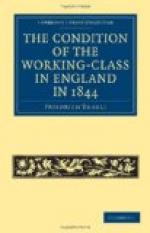portion of working humanity into the revolutionary
movement. But the longer agriculture had remained
stationary, the heavier now became the burden upon
the worker, the more violently broke forth the results
of the disorganisation of the old social fabric.
The “over-population” came to light all
at once, and could not, as in the manufacturing districts,
be absorbed by the needs of an increasing production.
New factories could always be built, if there were
consumers for their products, but new land could not
be created. The cultivation of waste common
land was too daring a speculation for the bad times
following the conclusion of peace. The necessary
consequence was that the competition of the workers
among each other reached the highest point of intensity,
and wages fell to the minimum. So long as the
old Poor Law existed, the workers received relief
from the rates; wages naturally fell still lower,
because the farmers forced the largest possible number
of labourers to claim relief. The higher poor-rate,
necessitated by the surplus population, was only increased
by this measure, and the new Poor Law, of which we
shall have more to say later, was now enacted as a
remedy. But this did not improve matters.
Wages did not rise, the surplus population could
not be got rid of, and the cruelty of the new law
did but serve to embitter the people to the utmost.
Even the poor-rate, which diminished at first after
the passage of the new law, attained its old height
after a few years. Its only effect was that
whereas previously three to four million half paupers
had existed, a million of total paupers now appeared,
and the rest, still half paupers, merely went without
relief. The poverty in the agricultural districts
has increased every year. The people live in
the greatest want, whole families must struggle along
with 6, 7, or 8 shillings a week, and at times have
nothing. Let us hear a description of this population
given by a Liberal member of Parliament as early as
1830. {264}
“An English agricultural labourer and an English pauper, these words are synonymous. His father was a pauper and his mother’s milk contained no nourishment. From his earliest childhood he had bad food, and only half enough to still his hunger, and even yet he undergoes the pangs of unsatisfied hunger almost all the time that he is not asleep. He is half clad, and has not more fire than barely suffices to cook his scanty meal. And so cold and damp are always at home with him, and leave him only in fine weather. He is married, but he knows nothing of the joys of the husband and father. His wife and children, hungry, rarely warm, often ill and helpless, always careworn and hopeless like himself, are naturally grasping, selfish, and troublesome, and so, to use his own expression, he hates the sight of them, and enters his cot only because it offers him a trifle more shelter from rain and wind than a hedge. He must support his family, though he cannot do




